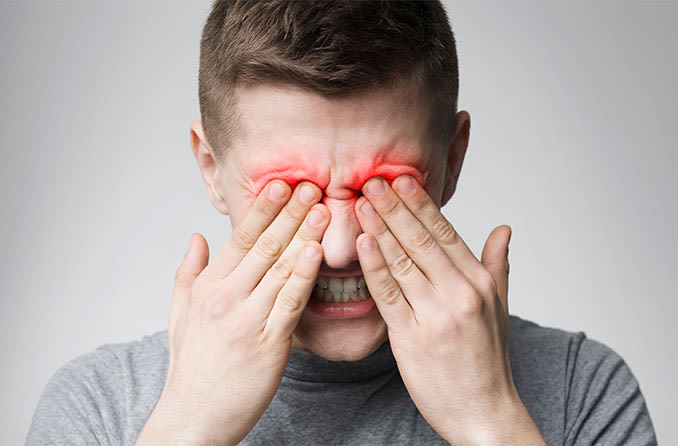Relieving sore, painful eyelids

Sore, painful eyelids can make anyone miserable, with constant aching and discomfort. To find the best source of relief for your eyelid pain, the cause must be determined first.
Causes and relief options for sore eyelids
Injury
The most common culprit for sore eyelids is injury, either as a result of surgery or an accident involving the eye. Blepharoplasty, a cosmetic eyelid surgery, involves making incisions in the eyelid, and it’s common for patients to experience pain in the upper or lower eyelid during recovery.
Minor eye injuries tend to get better on their own, but it’s possible for more serious ones to get infected. Swollen eyelids, fever and discharge from an injury are all signs of infection and should be met with medical attention.
How to get relief: If the injury doesn’t seem to be infected but your eyelids are sore, taking a pain reliever and resting your eyelids as much as possible can help with the pain. Injuries that are suspected of infection need to be evaluated by an eye doctor quickly. Antibiotics will likely be prescribed to quiet the infection and its accompanying symptoms.
Blepharitis
Inflammation of the eyelids (blepharitis) is another common cause of sore, red eyelids. Blepharitis can be caused by a bacterial or fungal eyelid infection or parasitic mites on the eyelashes.
How to get relief: Treatment for blepharitis can include eyelid scrubs, medicated eye drops and ointments, and/or in-office eyelid hygiene procedures. As a general rule, it’s always good to keep your eyes and eyelids clean, whether you’re susceptible to eyelid infection or not.
Using a gentle cleanser and a warm washcloth, wash your face and eyelids at least once a day to help prevent blepharitis from occurring.
SEE RELATED: Common causes of a swollen eyelid
Conjunctivitis
Conjunctivitis is inflammation of the clear mucous membrane that covers the white of the eye (the sclera) and the inner surface of the eyelids. Also called pink eye, conjunctivitis symptoms include red, irritated eyes; swollen, sore eyelids; and discharge.
There are several types of pink eye, including viral, bacterial and allergic. Though the symptoms are typically the same for all three, only viral and bacterial pink eye are contagious while symptoms are present.
How to get relief: Viral conjunctivitis cannot be treated with medication and must run its course, which typically lasts around a week. However, applying a cool compress to the eyelids can help relieve some of the itching and discomfort of viral pink eye.
Antibiotic eye drops may be used to treat the infection that causes bacterial conjunctivitis. This means a visit to the eye doctor is required so a proper treatment can be prescribed.
Itchy, swollen eyelids from allergic pink eye can be relieved by avoiding allergens and taking antihistamines in pill or eye drop form.
Stye
A stye is a localized infection of the eyelid that appears as a small, pimple-like bump on the upper or lower eyelid. A stye can be external, meaning it’s located along the lash line of the eyelid, or internal, meaning it’s an infected oil gland inside the eyelid.
Styes can be very tender, resulting in sore or painful eyelids.
How to get relief: Usually after a few days, the stye will come to a head and drain on its own. To speed up the process and relieve the tenderness experienced with a stye, you can use a warm compress on the eye for 10 to 15 minutes at a time, several times a day.
Avoid squeezing or attempting to “pop” a stye. This will cause more irritation and pain in the eyelid and may spread the infection.
SEE RELATED: Swollen eyelid FAQ
Contact lenses
Wearing contaminated or damaged contact lenses can cause eye irritation and eyelid pain. It’s important to properly clean and store contact lenses (if replaced on a biweekly or monthly basis) and throw out daily disposable contacts after every use as directed by your eye doctor.
How to get relief: If you wear contact lenses and you notice pain, irritation or swelling in your eyes or eyelids, the first thing you should do is remove your contacts. Clean them thoroughly and examine them for tears or holes.
It’s also important to never swim in your contact lenses or use tap water or saliva to clean them. Dangerous amoeba reside in water and can harm your vision through conditions such as Acanthamoeba keratitis.
Periorbital cellulitis
Cellulitis is a serious infection that grows in deep layers of the skin. In cases of periorbital cellulitis, the infection attacks the eyelids, causing pain and swelling. Additional symptoms include fever, difficulty or pain when moving the eyes, and eye bulging.
How to get relief: See an eye doctor immediately. Periorbital cellulitis is a serious, vision-threatening condition that needs to be addressed quickly. Treatment typically consists of antibiotics administered orally or intravenously.
When to see a doctor
If the eyelid pain you feel is severe, or if you have serious eyelid swelling in addition to pain, you need to see a doctor. Furthermore, if a fever is present with your eyelid or eye pain, medical attention is needed.
While eyelid soreness may be minor and not an immediate cause for concern, you should schedule a comprehensive eye exam if the soreness persists to pinpoint the cause of your eyelid pain and get on the right track for relief.
READ MORE: Home remedies for swollen eyes
Page published on Wednesday, October 14, 2020






